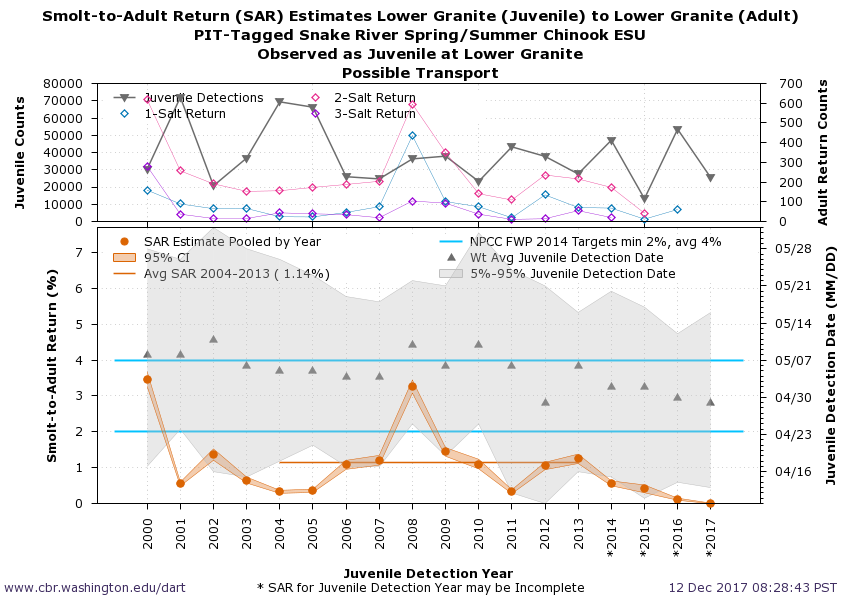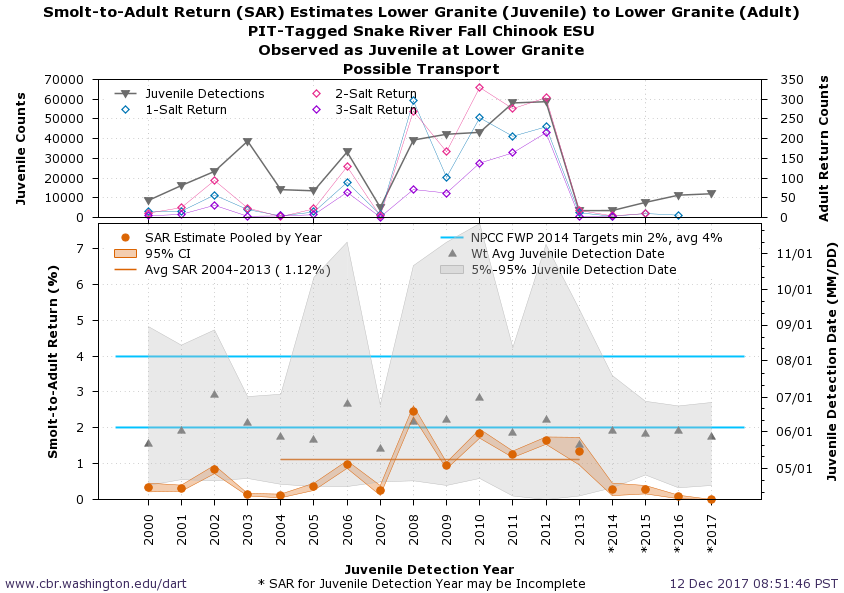The 2017 State of the Snake
Posted /UncategorizedIn 2017 the fish returns at Lower Granite dam are down for all categories compared to both the 10 year average and 2016. A total of 142,527 salmon and steelhead returned to Lower Granite Dam in 2017, a 35% reduction from 2016, which followed a 33% reduction from 2015 to 2016. These precipitous declines should come as no surprise. They were predicted in the 2015 Salmon White Paper which was distributed to Pacific NW state representatives as well as federal agency representatives.
Five-year reviews by NOAA show minimal improvement in the risk-status of ESA-listed salmon and steelhead despite a billion taxpayer dollars being spent on system improvements. Current NOAA recovery plans are predicted to NOT achieve fish recovery. Pacific NW state fisheries reports show that smolt-to-adult ratios have not improved either and still show Snake River fish returns are not meeting criteria for species survival.
| 2017 Fish Returns | Vs. 10-yr average | Vs. 2016 returns |
| Spring Chinook | -56% | -56% |
| Summer Chinook | -48% | -26% |
| Fall Chinook | -28% | -28% |
| Sockeye | -79% | -72% |
| Steelhead | -54% | -23% |
| Wild Steelhead | -66% | -38% |
Data from the Fish Passage Center, fpc.org
Snake River wild steelhead are on a decline to levels not seen in 20 years. Adult returns in 2017 will mark the second steepest 5-year trend since the 2009-2013 trend. The third worst 5-year trend will be from 2002-2006 adult counts. This recent 5 year trend is so low that it will hit a trigger point in the 2014 biological opinion. The BiOp states that the agencies must implement a solution within 12 months. However, the downward trend is not the only problem; the actual number of wild steelhead is now so low that the only solution or recovery action that can be implemented quick enough to prevent virtual extinction is the breaching alternative in the existing EIS for the 4 Lower Snake River dams. Run declines of other species point to 2018 breaching as well.
From the 2016 and 2017 NOAA Recovery Plan for Snake River Spring/Summer Chinook Salmon & Snake River Steelhead, National Marine Fisheries Service, West Coast Region
“Over $1 billion has been invested since the mid-1990s in baseline research, development, and testing of prototype improvements, and construction of new facilities and upgrades.”
“NMFS estimates that recovery of the Snake River spring/summer Chinook salmon ESU and steelhead DPS, like recovery for most of the ESA-listed Pacific Northwest salmon and steelhead, could take 50 to 100 years.” But further states: “This recovery plan contains an extensive list of actions to move the ESU and DPS towards viable status; however, the actions will not get us to recovery.”
From the 2016 Comparative Survival Study SAR Patterns: Snake and Mid-Columbia
SAR (smolt to adult return ratio) is a measure of fish survival, or the % of smolts that return as spawning adults. The Northwest Power & Conservation Council’s goals are 2% for mere survival of the species and 6% for recovery of the species. Overall, Snake River Chinook and steelhead SARs have only been above 2% in 5 of 20 years in recent history (and never above 6%). These results are in spite of increased spill and barging around the dams. In contrast, Mid-Columbia Chinook and steelhead are generally meeting the NPCC SAR goals and have SAR ratios 2.3X – 3.4X greater than Snake River wild SARs. Keep in mind that Snake River salmon and steelhead pass over 8 dams… 4 on the Columbia and 4 on the Snake. Mid-Columbia fish only pass 1- 4 lower Columbia dams. If the 4 lower Snake River dams were removed, Snake River salmon and steelhead would have very similar migration and spawning conditions, which should lead to fish recovery. See charts below for trend of SAR’s below 1.
From the Draft Comparative Survival Study 2017 Annual Report by the Fish Passage Center
“If the lower four Snake River dams are breached and the remaining four Columbia dams operate at BiOp spill levels, we predict approximately a 2-3 fold increase in abundance above that predicted at BiOp spill levels in an impounded system, and up to a 4 fold increase if spill is increased to the 125% TDG limit. This analysis predicts that higher SARs and long-term abundances can be achieved by reducing powerhouse passage and water transit time*, both of which are reduced by increasing spill, and reduced further when the lower four Snake River dams are breached.”
*At the dams, river transit time unaffected.


John Twa
2017.12.14
